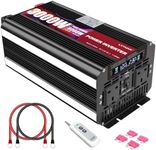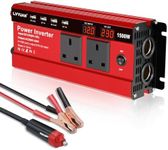Buying Guide for the Best Rv Inverters
Choosing the right RV inverter is crucial for ensuring that you have a reliable power source while on the road. An inverter converts DC power from your RV's batteries into AC power, which is used to run most household appliances. When selecting an RV inverter, it's important to consider your power needs, the types of appliances you plan to use, and the overall efficiency and reliability of the inverter. Here are some key specifications to consider when making your choice.Power Output (Wattage)Power output refers to the maximum amount of power the inverter can provide at any given time. This is important because it determines what appliances you can run simultaneously. Inverters typically range from 300 watts to several thousand watts. If you plan to run small devices like laptops and lights, a lower wattage inverter (300-1000 watts) may suffice. For larger appliances like microwaves, air conditioners, or multiple devices at once, you'll need a higher wattage inverter (1000-3000 watts or more). Assess your power needs by listing the appliances you intend to use and their wattage requirements.
Waveform TypeInverters produce either modified sine wave or pure sine wave AC power. Modified sine wave inverters are generally less expensive and suitable for most basic electronics and appliances. However, pure sine wave inverters provide cleaner power that is compatible with sensitive electronics and appliances, such as medical equipment, microwaves, and some power tools. If you plan to use sensitive or high-end electronics, a pure sine wave inverter is recommended. For basic usage, a modified sine wave inverter may be sufficient.
EfficiencyEfficiency refers to how well the inverter converts DC power to AC power. Higher efficiency means less power is lost during the conversion process, which can be important for conserving battery life. Inverters typically have efficiency ratings between 85% and 95%. If you are looking to maximize your battery life and reduce energy waste, opt for an inverter with higher efficiency. This is particularly important for extended trips or off-grid camping.
Input VoltageInput voltage is the voltage required from your RV's battery system to operate the inverter. Common input voltages are 12V, 24V, and 48V. Most RVs use a 12V battery system, but some larger setups may use 24V or 48V systems. Ensure that the inverter you choose matches your RV's battery system voltage. If you have a 12V system, select a 12V inverter; if you have a 24V system, select a 24V inverter, and so on.
Size and WeightThe size and weight of the inverter can be important depending on the available space in your RV and how you plan to install it. Larger inverters with higher power outputs tend to be bulkier and heavier. Consider where you will install the inverter and ensure you have adequate space and mounting options. If space is limited, look for a compact and lightweight model that still meets your power needs.
Safety FeaturesSafety features such as overload protection, short circuit protection, and thermal shutdown are crucial for preventing damage to your inverter and appliances. These features help protect against electrical faults and overheating, ensuring safe operation. Look for inverters that include these safety features to ensure reliable and safe use, especially if you plan to run multiple or high-power appliances.














